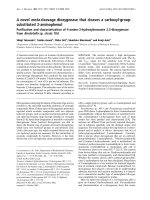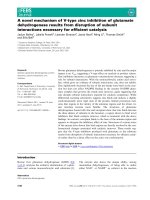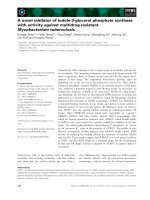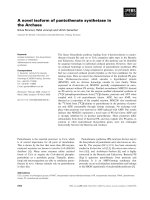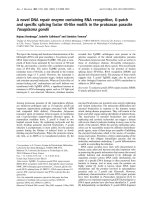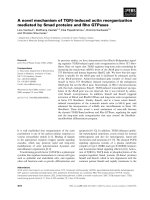Báo cáo y học: "A novel combination of Chinese medicines to treat advanced cancers and lymphomas in rats" ppt
Bạn đang xem bản rút gọn của tài liệu. Xem và tải ngay bản đầy đủ của tài liệu tại đây (266.53 KB, 6 trang )
BioMed Central
Page 1 of 6
(page number not for citation purposes)
Chinese Medicine
Open Access
Research
Effects of Kombucha on oxidative stress induced nephrotoxicity in
rats
Ola Ali Gharib
Address: Drug Radiation Research Department, National Centre for Radiation Research and Technology, Atomic Energy Authority, Nasr City,
Cairo, Egypt
Email: Ola Ali Gharib -
Abstract
Background: Trichloroethylene (TCE) may induce oxidative stress which generates free radicals
and alters antioxidants or oxygen-free radical scavenging enzymes.
Methods: Twenty male albino rats were divided into four groups: (1) the control group treated
with vehicle, (2) Kombucha (KT)-treated group, (3) TCE-treated group and (4) KT/TCE-treated
group. Kidney lipid peroxidation, glutathione content, nitric oxide (NO) and total blood free radical
concentrations were evaluated. Serum urea, creatinine level, gamma-glutamyl transferase (GGT)
and lactate dehydrogenase (LDH) activities were also measured.
Results: TCE administration increased the malondiahyde (MDA) and NO contents in kidney, urea
and creatinine concentrations in serum, total free radical level in blood and GGT and LDH activities
in serum, whereas it decreased the glutathione (GSH) level in kidney homogenate. KT
administration significantly improved lipid peroxidation and oxidative stress induced by TCE.
Conclusion: The present study indicates that Kombucha may repair damage caused by
environmental pollutants such as TCE and may be beneficial to patient suffering from renal
impairment.
Background
Kombucha is a sour beverage prepared from the fermenta-
tion of black tea and sugar with a symbiotic culture of ace-
tic acid bacteria and yeasts such as Bacterium xylinum,
Bacterium xylinoides, Bacterium gluconicum, Saccharomyces
ludwigii, Saccharomyces apiculatus varieties, Schizosaccaromy-
ces pombe, Acetobacter ketogenum, Torula varieties, Pichia fer-
mantans and other yeasts reported to have potential health
effects [1]. Fermentation and oxidation processes of Kom-
bucha microorganisms produce a wide range of organic
acids, vitamins and enzymes. Research indicated that
Kombucha improved resistance against cancer, prevented
cardiovascular diseases, promoted digestion, stimulated
immunity and reduced inflammation [2].
Glucuronic acid is one of the organic acids produced dur-
ing fermentation process in Kombucha and may improve
oxidative metabolism [3]. Trichloroethylene (TCE) is a
Published: 27 November 2009
Chinese Medicine 2009, 4:23 doi:10.1186/1749-8546-4-23
Received: 10 June 2009
Accepted: 27 November 2009
This article is available from: />© 2009 Gharib; licensee BioMed Central Ltd.
This is an Open Access article distributed under the terms of the Creative Commons Attribution License ( />),
which permits unrestricted use, distribution, and reproduction in any medium, provided the original work is properly cited.
Chinese Medicine 2009, 4:23 />Page 2 of 6
(page number not for citation purposes)
major environmental contaminant and an occupational
concern due to its widespread industrial use [4]. An ani-
mal carcinogen, TCE is nephrotoxic and causes renal
tumors in rats [5]. The toxicity of TCE is dependent on its
reactive metabolites derived from the reaction of glutath-
ione conjugating with TCE, followed by subsequent
metabolism by gamma-glutamyl transferase (GGT),
dipeptidases and cystein conjugate B-layse [6]. Previous
studies found significant renal dysfunction in male
Sprague Dawley rats exposed to TCE. The renal dysfunc-
tion was manifested by glycosuria and alterations in
plasma creatine, urine nitrogen, uric acid and creatine
clearance, concentration related changes in hematocrit
and erythrocytes, as well as reticulocyte and erythroblast
counts [7,8].
TCE induced oxidative stress [9] which is considered an
imbalance between the production of oxidizing molecu-
lar species (free radicals) and the presence of cellular anti-
oxidants [10]. Containing unpaired electron, free radicals
are highly reactive and cause damage to part of cells by
inducing DNA strand breaks, purine oxidation and pro-
tein DNA cross linking and cell membrane damage [11].
Accumulation of such damage may cause cell death [12].
Wang et al. [13] reported that TCE exposure not only
increased lipid peroxidation but also accelerated autoim-
mune responses. Lash et al. documented that kidney cells
from male rats are more sensitive to TCE than those from
female rats or hepatocytes from rats of either sex [14].
Moreover acute renal cellular injury from TCE is believed
to be associated with metabolites derived from the GSH
conjugation pathway [6]. The first step involve conjuga-
tion with GSH that catalyze by the GSH transferase to
form the GSH conjugate DCVG and processing of the
GSH conjugate by GGT and dipeptidase activities to gen-
erate the cystein conjugate S-(1,2-dichlorovinyl) L. cystein
(DCVC) [14]. DCVC may also undergo sulfoxidation to
form S-(1-chloro-2-(S-glutathionyl)-L-cystein sulfoxide
(DCVC sulfoxide), which is a potent nephrotoxicant in rat
kidney cells [15].
The present study aims to investigate the antioxidant
properties of Kombucha constituents and the protective
effects of Kombucha on the kidney of TCE-treated rats.
Methods
Animals
Twenty male albino rats weighing 150-200 g were pur-
chased from the Egyptian Organization for Biological
Products and Vaccines (Cairo, Egypt). Animals were
housed in cages with good ventilation and illumination
and provided with standard diet and water ad-libitum. All
procedures in the present study conform to international
animal care guidelines and the ethics committee of the
institution.
Chemicals
Analytical-grade TCE was purchased from El-Nasr Phar-
maceutical Chemical (Egypt). All other chemicals and
bio-chemicals were obtained from Sigma Chemical
(USA). The kits used in the experiments were purchased
from Bio-Diagnostics (UK).
Preparation of Kombucha
One hundred grams (100 g) of sugar was added to one
liter (1 L) of distilled water, and the solution was boiled
for 15 minutes in a sterile conical flask. Six tea bags of
black tea powder (Lipton, Egypt) were added to the flask
(12 g/L, 1.2%) and allowed to cool to room temperature
for one hour.
Fermentation
Kombucha culture was kept under aseptic conditions. Fer-
mentation was carried out by incubating the Kombucha
culture at 28 ± 1°C for 8-10 days. Subsequently, the
medium (brew) was centrifuged at 3000 rpm for 30 min-
utes aseptically and stored in polypropylene vials at -20°C
for further use [16].
Study design
Rats were divided into four groups (5 rats per group),
namely the control group, Kombucha (KT) group, TCE
group and KT/TCE group. In the control group, animals (n
= 5) were gavage fed with maize oil (vehicle of TCE) for
ten consecutive days. In the KT group, animals (n = 5)
were administered with KT ferment per oral (0.1 ml per
100 g of body weight) for two weeks [17]. In the TCE
group, animals (n = 5) were administrated with TCE (1 g
per kg of body weight) per oral for ten consecutive days
[18]. In the KT/TCE group, animals (n = 5) were adminis-
tered with KT ferment first for two weeks and subse-
quently gavage fed with TCE for ten consecutive days.
Animals were sacrificed 24 hours after TCE administra-
tion. Kidneys were removed. Serum was isolated for the
assessment of kidney functions.
Total free radicals assay by electron spin
resonancetechnique (ESR)
Electron spin resonance occurs when a spinning electron
in an externally applied magnetic field absorbs sufficient
electromagnetic radiation to cause inversion of electrons
spin state (e.g. transfer from ground state to excited state).
This technique is used to study free radical concentrations
in biological materials by detecting the molecules with
unpaired electrons (free radicals) without destroying
them. Free radicals from biological materials such as reac-
tive oxygen species (O2
-
), hydroxyl radical (OH
-
), nitro-
Chinese Medicine 2009, 4:23 />Page 3 of 6
(page number not for citation purposes)
gen oxide (NO
-
) and hypochlorous acid (HOCL
-
) are
responsible for certain diseases [19].
Preparation of lyophilized blood samples for ESR
Blood samples were lypophilized in a super Modulyo
freeze dryer (Edwards Vacuum, UK).
ESR spectrometer
ESR or electron paramagnetic resonance (EPR) signals
were recorded at room temperature by a Bruker EMX spec-
trometer (X band, Bruker, Germany). ESR detection limits
(1013 spins/g) depend on the sample type, sample size,
detector sensitivity, frequency of incident radiation and
electronic circuit of the instrument.
Measurement and analysis of ESR spectra
Samples were inserted into the EPR of quartz tubes and
measured at suitable instrument parameters. The peak
height of the radiation-induced EPR signals was deter-
mined for each sample. The reading intensities were
divided by the weight of each sample for normalization.
To monitor variation in the peak height EPR signals as a
function of magnetic field, we measured intensities as the
distance between top and bottom points of the first deriv-
ative and the reading intensities were divided by sample
weight of each sample for the calculation of normaliza-
tion values which were recorded according to Gohn [20]
and Pascual et al. [21].
Biochemical assays
All biochemical assays were performed with a Helios
Thermo-Spectronic spectrophotometer (Thermo Spec-
tronic, UK). Lactate dehydrogenase (LDH) activity was
evaluated according to the method by IFCC [22]. GGT
activity was evaluated according to the method by Szasz
[23]. Urea concentration was measured according to the
method by Halled and Cook [24] with a Bio-Diagnostic
kit. Creatinine level was measured according to the
method by Henery [25] with a Bio-Diagnostic kit. Total
protein of serum and kidney was measured according to
the method by Gomal et al. [26]. Concentration of kidney
malondialdehyde (MDA) was analyzed according to the
method by Yoshioka et al. [27]. Kidney homogenate of
both GSH content was measured according to the method
by Beutler et al. [28]. Nitric oxide (NO) concentration was
measured according to the method by Geng et al. [29].
Statistical analysis
Quantitative data were expressed as mean ± SD (standard
deviation) and analyzed by one way analysis of variances
(ANOVA) followed by Tukey's multiple comparison test.
Statistical analysis was performed with the GraphPad soft-
ware (USA). Differences were considered statistically sig-
nificant when P < 0.05.
Results
In the present study, kidney protection effects of KT were
investigated through kidney functions affected by carcin-
ogen, e.g. serum urea, creatinine concentration, LDH and
GGT activity.
TCE administration
TCE administration significantly increased urea (P <
0.001) and creatinine (P < 0.01) levels in rats (Table 1).
Administration of TCE induced a marked oxidative stress
measured by lipid peroxidation (P < 0.001) and signifi-
cant inhibition in GSH content (P < 0.01).
Serum LDH activity (P < 0.001) and kidney NO concen-
tration (P < 0.001) were significantly increased (Table 2).
TCE administration significantly increased total free radi-
cals in blood (P < 0.001) and in serum GGT activity (P <
0.01) (Figure 1).
Recovery
Data of kidney GSH (Table 3) and LDH and NO concen-
tration (Table 2) showed that KT administration restored
these parameters to normal values in TCE-treated rats.
Moreover, a significant improvement in serum creatinine
and kidney MDA was observed (Tables 1 and 3).
Discussion
The present study confirms the findings of Goel et al. and
Khan et al. that TCE significantly increased urea and creat-
inine in rats [30,31] and that TCE also increased the activ-
ity of LDH as reported by Lash et al. [32]. Moreover,
oxidative markers measured as lipid peroxidation in kid-
ney tissue and total free radicals in blood increased mark-
edly followed by a decrease in kidney glutathione content.
The present study confirms the previous study [6] that
GGT was increased due to TCE administration. Further-
more, the present study shows that the depletion of GSH
enhances utilization of protein thereby increasing the
urea level that is accompanied by an increased creatinine
level suggested by Mostafa [33].
Table 1: Effects of KT and TCE administration on serum urea
(mmol/l) and creatinine (mg/dl) concentrations 24 hours after
last treatment (n = 5)
Treatment Urea concentration
(mmol/l)
Creatinine concentration
(mg/dl)
Control 3.635 (0.388) 0.864 (0.0921)
KT 3.896 (0.34) 0.824 (0.1315)
TCE 7.381 (0.881)
(a, b)
1.112 (0.0867)
(a, b)
KT+TCE 5.794 (1.492)
(a, b, c)
0.952 (0.0335)
Data are presented as mean (SD).
(a)
Significantly different from the
control group (P < 0.05).
(b)
Significantly different from the KT group
(P < 0.05).
(c)
Significantly different from the TCE group (P < 0.05). KT:
Kombucha, TCE: trichloroethylene.
Chinese Medicine 2009, 4:23 />Page 4 of 6
(page number not for citation purposes)
Kombucha is a potent antioxidant demonstrated to
reduce the damage induced by oxidative stress [16,27,34-
36]. Results from the present study show that Kombucha
ferment ameliorated TCE-induced kidney damage, attrib-
utable to acetic acid which is capable of conjugating with
toxins, solubilizing and eliminating them from the body
[37]. Glucuronic acid, another important acid in Kom-
bucha, facilitates the detoxification process in the body.
UDP-glucuronic acid is formed in the liver of all animals
and conjugates toxins for subsequent elimination [3].
Andlaur et al. reported that potential phytochemical tox-
ins were detoxified in mammalian tissue by conjugation
with glucuronic acid [38].
Conclusion
The present study indicates that Kombucha may repair
damage caused by environmental pollutants such as TCE
and may be beneficial to patient suffering from renal
impairment.
Abbreviations
DCVC: S-(1, 2-dichlorovinyl) L. cysteine; DCVC sulfox-
ide: S-[1-chloro-2-(glutathionyl) vinyl]-L-cysteine sulfox-
ide); GGT: gamma glutamyl transpeptidase; GSH:
glutathione; GSH transferase: glutathione transferase; KT:
Kombucha; LDH: lactate dehydrogenase; MDA: malondi-
Effects of KT and TCE administration on blood total free radicals 24 hours after last treatment (n = 5)Figure 1
Effects of KT and TCE administration on blood total free radicals 24 hours after last treatment (n = 5). *Signifi-
cantly different from the control group (P < 0.05). KT: Kombucha. TCE: trichloroethylene.
dicals
/
g
*
/
L)
*
o
od total free radicals
10
17
radicals/g
*
GGT activity (U/L)
*
Blood total free radicals
10
17
radicals/g
(
a
)
*
GGT activity (U/L)
(
b
)
*
Blood total free radicals
10
17
radicals/g
(a)
*
GGT activity (U/L)
(b)
*
Table 2: Effects of KT and TCE administration on serum LDH (U/L) activity and kidney NO (μmol/g protein) concentration 24 hours
after last treatment (n = 5)
LDH activity (U/L) NO concentration (μmol/g protein)
Control 377.6 (39.72) 19.78 (1.808)
KT 366.2 (44.65) 21.93 (2.095)
TCE 551.2 (68.89)
(a, b)
39.08 (6.562)
(a, b)
KT+TCE 395.6 (32.19)
(c)
29.22 (4.181)
(a)
Data are presented as mean (SD).
(a)
Significantly different from the control group (P < 0.05).
(b)
Significantly different from the KT group (P < 0.05).
(c)
Significantly different from the TCE group (P < 0.05). KT: Kombucha, TCE: trichloroethylene.
Chinese Medicine 2009, 4:23 />Page 5 of 6
(page number not for citation purposes)
aldehyde, lipid peroxidation marker; NO: nitric oxide;
TCE: trichloroethylene; U/L: unit per liter.
Competing interests
Kombucha used in the present study was supplied by the
microbiology lab of the National Center for Radiation
Research and Technology (NCRRT), Atomic Energy
Authority (Cairo, Egypt) where the author is employed.
Authors' contributions
OAG conceived of the study design, carried out the exper-
iments, performed statistical analysis and drafted the
manuscript. The author read and approved the final ver-
sion of the manuscript.
Acknowledgements
The author is grateful to Dr Abdo Mansour at the Department of Radiation
Physics of the NCRRT for analyzing the ESR spectra.
References
1. Morales GB, Sanchez HH: Manufacture of a beverage from
cheesewhey using "tea fungus" fermentation. Rev Latinoam
Microbiol 2003, 45:5.
2. Dufresne C, Farnworth E: Tea, kombucha health: a review. Food
Res Int 2000, 336:409-421.
3. Blanc PJ: Characterization of the tea fungus metabolites. Bio-
technol Lett 1996, 18(2):139-143.
4. Davidson IW, Belilies RP: Consideration of the target organ tox-
icity of trichloroethylene in terms of metabolite toxicity and
pharmacokinetics. Drug Metab Rev 1991, 23:493-599.
5. Maltoni C, Lefemine G, Gotti G, Perrino G: Long term carcino-
genicity bioassays on trichloroethylene administered by
inhalation to Sprague Dawley rats and Swiss and B6C3F1
mice. Ann N Y Acad Sci 1988, 534:216-342.
6. Geoptar AR, Commandeur JNM, Van Ommen B, Van Bladeren PJ,
Vermenten NPE: Metabolism and kinetics of trichloroethylene
in relation to toxicity and carcinogenicity. Relevance of the
mercapturic acid and pathway. Chem Res Tocicol 1995,
8(1):3-21.
7. Nomiyama K, Nomiyama H, Arai H: Revaluation of sub-chronic
toxicity of trichloroethylene. Toxicol Lett 1986, 31(l):225.
8. Agency for Toxic Substances and Disease Registry (ATSDR): Toxico-
logical profile for trichloroethylene (TCE) Atlanta: US Department of
Health and Human Services Public Health Service; 1997.
9. Cojocel C, Beuter W, Muller W, Mayer D: Lipid peroxidation: a
possible mechanism of trichloroethylene induced nephero-
toxicity. Toxicol 1989, 55(1-2):131-141.
10. Dalton TP, Shertzer HG, Puga A: Regulation of gene expression
by reactive oxygen. Annu Rev Pharmacol Toxicol 1999, 39:67-101.
11. Giordano FJ: Oxygen, oxidative stress, hypoxia, and heart fail-
ure. J Clin Invest 2005, 115(3):500-508.
12. Halliwell B, Whiteman M:
Measuring reactive species and oxida-
tive damage in vivo and in cell culture: how should you do it
and what do the results mean? Br J pharmacol 2004,
142(2):231-255.
13. Wang G, Ansari GA, Khan MF: Involvement of lipid peroxidation
derived aldehyde- protein adducts in autoimmunity medi-
ated by trichloroethylene. J Toxicol Environm Health 2007,
70(23):1977-1985.
14. Lash LH, Qian W, Putt DA, Hueni SE, Elfarra AA, Krause RJ, Parker
JC: Renal and hepatic toxicity of trichloroethylene and its glu-
tathione- derived metabolites in rats and mice: sex-, species-
, and tissue dependent differences. J Pharmacol Exp Therp 2001,
297(1):155-164.
15. Lash LH, Tokarz JJ, Woods EB: Renal cell type specificity of
cephalosporin- induced cytotoxicity in suspensions of iso-
lated proximal tubular and distal tubular cells. Toxicology 1994,
94:97-118.
16. Sai Ram M, Anju BPT, Dipti P, Kain AK, Mongia SS, Sharma SK, Singh
B, Singh R, Ilavazhagan G, Devendra Kumar, Selvamurthy W: Effect
of Kombucha tea on chromate (VI)-induced oxidative stress
in albino rats. J Ethnopharmacol 2000, 71(1-2):235-240.
17. Gharib OA, Fahim TH: Possible protective effect of kombucha
tea ferment on carbon tetrachloride induced liver damage in
irradiated rats. Egypt J Rad Sci Applic 2007, 21(1):97-115.
18. Elcombe CR, Rose MS, Pratt IS: Biochemical, histological, and
ultrastructural changes in rats and mouse liver following the
administration of trichloroethylene: possible relevances to
species differences in hepato-carcinogenicity. Toxicol Appl Phar-
macol 1985, 79(3):365-376.
19. Heckly RJ: Biological applications of electron spin resonance.
In Free Radicals in Dry Tissues Edited by: Swartz HM, Bolton JR, Borg
DC. New York: Wiley InterScience; 1972:5.
20. Gohn A: ESR and Elementary Practical Applications New York: John
Wiley; 1986.
21. Pascual EC, Goodman BA, Yeretzian C: Characterization of free
radicals in soluble coffee by electron paramagnetic reso-
nance spectroscopy. J Agri Food Chem 2002, 50(21):6114-6122.
22. IFCC: Measurements of lactate dehydrogenase in serum. J
Clin Chem Clin Biochem 1980,
18:521.
23. Szasz G: A kinetic photometric method for serum gamma
glutamyl transpeptidase. Clin Chem 1969, 15(2):124-136.
24. Halled CJ, Cook JG: Reduced nicotinamide adenine dinucle-
otide-coupled reaction for emergency blood urea estima-
tion. Clin Chim Acta 1971, 35:33-40.
25. Henery RJ: From Principle and Techniques: Clinical chemistry 2nd edition.
New York: Harper & Row; 1974:525.
26. Gomal AC, Bardawill CJ, David MM: Colorimetric method for
total protein determination. J Biol Chemi 1949, 177:751.
27. Yoshioka T, Kawada K, Shimada T, Mori M: Lipid peroxidation in
maternal and cord blood and protective mechanism against
activated-oxygen toxicity in the blood. Am J Obstet Gynecol
1979, 135(3):372-376.
28. Beutler E, Duran O, Kelly BM: Improved method of blood glu-
tathione. J Lab Clin Med 1963, 61(5):852-855.
29. Geng Y, Almqvist M, Hansson GK: DNA cloning and expression
of inducible nitric oxide synthase from rat vascular smooth
muscle cells. Biochim Biophys Acta 1994, 1218:421.
30. Goel SK, Rao GS, Pandya KP, Shanker R: Trichloroethylene toxic-
ity in mice: a biochemical, hematological and pathological
assessment. Indian J Exp Biol 1992, 30(5):402-6.
31. Khan S, Priyamvada S, Khan SA, Khan W, Farooq N, Khan F, Yusufi
AN: Effect of trichloroethylene (TCE) toxicity on the
enzymes of carbohydrate metabolism, brush border mem-
brane and oxidative stress in kidney and other rat tissues.
Food Chem Toxicol 2009, 47(7):1562-1568.
32. Lash LH, Qian W, Putt DA, Hueni SE, Elfarra AA, Sicuri AR, Parker
JC: Renal toxicity of perchloroethylene and S-(1,2,2-trichlo-
rovinyl)glutathione in rats and mice: sex- and species-
dependent differences. Toxicol Appl Pharmacol 2002,
179(3):163-171.
33. Mostafa SA: Effect of allyl as glutathione depleting agent on
carbohydrate metabolism in rats.
Egypt J Ger Soc Zool 1998,
26(A):13-34.
Table 3: Effects of KT and TCE administration on kidney MDA
(μmol/g protein) concentration and GSH (mg/g protein) content
24 hours after last treatment (n = 5)
MDA concentration
(μmol/g protein)
GSH content
(mg/g protein)
Control 22.020 (4.385) 1.242 (0.0471)
KT 21.800 (2.142) 1.416 (0.1711)
TCE 36.13 (1.461)
(a, b)
0.908 (0.0814)
(a, b)
KT+TCE 27.300 (3.179)
(b, c)
1.229 (0.1794)
(c)
Data are presented as mean (SD).
(a)
Significantly different from the
control group (P < 0.05).
(b)
Significantly different from the KT group
(P < 0.05).
(c)
Significantly different from the TCE group (P < 0.05). KT:
Kombucha, TCE: trichloroethylene.
Publish with BioMed Central and every
scientist can read your work free of charge
"BioMed Central will be the most significant development for
disseminating the results of biomedical research in our lifetime."
Sir Paul Nurse, Cancer Research UK
Your research papers will be:
available free of charge to the entire biomedical community
peer reviewed and published immediately upon acceptance
cited in PubMed and archived on PubMed Central
yours — you keep the copyright
Submit your manuscript here:
/>BioMedcentral
Chinese Medicine 2009, 4:23 />Page 6 of 6
(page number not for citation purposes)
34. Gharib OA: Does kombucha tea reduce the damage induced
by radiation exposure? Egypt J Sci Applic 2007, 20(1):141-157.
35. Gharib OA, Gharib MA: Kombucha tea ameliorates trichlo-
roethylene induced hepatic damages in rats via inhibition of
oxidative stress and free radicals induction. Egypt J Sci Applic
2008, 21(2):481-498.
36. Anand SS: Protective effect of vitamin B6 in chromium-
induced oxidative stress in liver. J Appl Toxicol 2005, 25:440-443.
37. Dutton G: Glucuronidation of Drugs and Other Compounds CRC Press;
1980.
38. Andlaur W, Kolb J, Furst PA: Novel efficient method to identify
beta-glucuroindase activity in rat small intestine. Parenter
Enteral Nutr 2000, 24(5):308-310.

